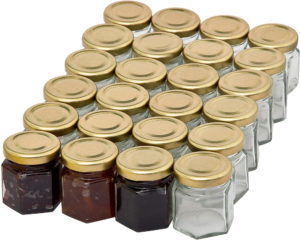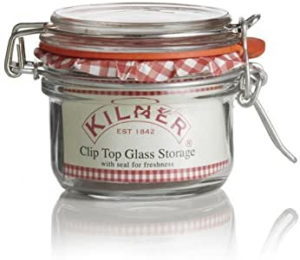Amy C. Fitzjohn's Blog, page 11
August 25, 2020
Big Dreams, Shallow Pockets: Help To Start A Business (UK)

Is It All Change For You?
As lockdown eases and we slowly get comfortable with our new reality, many of us are questioning the work we do and the choices we’ve made.
Here in the UK millions of employees were furloughed.
The fact that so many jobs could so easily be put on hold illustrates how, in the grand scheme of things, so many of them could be viewed as pointless.
You could argue that a lot of jobs exist solely for the purpose of employing people, in order to keep the wheels of capitalism churning away, eating resources.
Other jobs have simply disappeared or businesses have failed, unable to survive months of lockdown.

How Have Your Spent Your Time?
Being safe at home, many of us have had more time on our hands.
We’ve been spending it in different ways, doing things we enjoy or reflecting on what we did with our time while employed. We’re questioning what we want from life.
Often, pursuing something you would rather do with your time will involve becoming self-employed.
It could be a hobby. Or a skill that doesn’t fit neatly into an employed role.
Perhaps it’s practical and pragmatic reasons:
you have caring responsibilities or health concerns that make traditional 9 to 5 Monday to Friday jobs inaccessible.
Resist The Dead End Job

It may be that you have simply had enough of horrible employers and dead-end jobs where you feel undervalued, under-stimulated, and under-appreciated.
It could be a combination of these and other factors.
There are many reasons to choose a self-employed career route.
Take Your First Step
But what’s the first step?
How does it all work?
What do you need to consider and who can help you figure it out without charging you a small fortune in consulting fees?
There is so much info online, it can be overwhelming – Who do you trust and what’s the next step?

Funding For Your Business
While funded provisions are getting scarcer and have more and more specific criteria to access help, there is still support available backed by local, regional, national governments and agencies.
There used to be funded provision for regional development and business support from the EU, but… let’s not go there!
Before you spend money on business start-up support, it is definitely worth doing a little digging, there is free support out there. Getting help before you start will definitely smooth the transition for you (and save you a lot of money and risk)!
Some local Councils and Enterprise Agencies are better funded than others, it is, unfortunately, something of a postcode lottery depending on how affluent or otherwise your local area is.
What Business Support Is Available In Your Area?
I’m in Bristol, UK, so some of the provisions I’m sharing here may not be available for you, however, they are an example of the type of help available. If it’s available in the Bristol area, there may be an equivalent where you are.
Bristol City Council’s List of support to start business is HERE
It’s relatively comprehensive, but there are other schemes available locally that I have listed later.
Other schemes listed here are national, but there will be certain criteria you need to meet in order to access provisions.
It’s worth noting that grants are extremely rare and extremely unlikely for a start up business. Unfortunately, no one is going to give you hard cash to get your business started (unless you pay it back – there are loan schemes etc.).
Most funded provision comes in the form of training and access to specialists.
I’ve made these lists as comprehensive as I could at the time of writing this, but this is not an exhaustive risk, there will be other projects offering support, I’ve gone for the ones that have broader criteria and that I have used, delivered for or am aware of.
Micro-Enterprise is Different to Small Business
I’ve written previously about how small business support so often overlooks micro-enterprise; how individuals in business don’t seem to exist in the eyes of policymakers.
I firmly believe this and in the years I’ve been self-employed if anything this support has dwindled.
However, there are small pockets of funding for training and development, even if there is very little hard currency available!

Grab All The Free Help You Can Get
My advice: seek out free support in your local area and do everything you can.
Running a business isn’t easy, there are many things you need to think about that you take for granted as an employee.
As a small business owner, you will find that much of your time is filled with the basic tasks of running the actual business rather than doing the thing you do!
You don’t know what you don’t know, so swallow your pride, admit you still have something to learn and go to the webinars, seminars, events, talks and training whenever you can.
Skills Overwhelm
Learning to run a business depends on a range of skills.
The first lesson I learned as a start-up, especially in the early days, most of your working week will be taken up with marketing activities. Unless you come from a marketing background, this alone is a huge topic with a steep learning curve.
Even if you come from a marketing background, there is a world of difference between creating and running marketing campaigns for an employer with a budget, to doing it for your own business.
Admit It, We All Need Help
Sure, you could be an arrogant fool and think you can do it all and know what to do, but you’ll waste money, time and energy figuring something out that you could learn in a short free workshop, or with some targeted 1 to 1 time with an expert in that field.
That’s your choice.

Far from admitting you don’t have all the answers being a sign of weakness, there is strength in reaching out for help. We are stronger together.
Just because your are ‘self’ employed doesn’t mean you have to do everything yourself.
You pay your taxes, use the resources they pay for when you can to benefit yourself, your business and your family.
Ultimately, local, regional and national authorities put these provisions in place because they know that helping people who want to be self-employed to do it properly will save them money. They will pay out fewer benefits and receive more tax. If people are empowered to create their own jobs and small businesses it benefits everyone. Indeed, micro-businesses are the lifeblood of the economy, without us, we’d be in far worse shape as a nation and indeed, across the world!
Micro-businesses create jobs (even if it’s just a job for yourself) and many become the employers of the future, creating other jobs, even if it’s a part-time assistant, an apprentice or intern.
Micro-enterprises pay it forward in a powerful and, sadly, undervalued way.
What If I Fail?
It is true that anything up to 80% of small businesses fail in the first year.

There are many reasons for this, most of which can be overcome with a little prior knowledge.
Here are a few of the main reasons businesses fail:
Competitors out perform them – If you develop, learn new skills and continually research and improve your practice this is less likely to happen. Your competitors are probably investing time, energy and money into getting the right advice and support so you should too. And if they are not, you will definitely reap the rewards by doing it!
Cashflow problems – If you ask for help instead of throwing money at the problem and actually learn how to budget and run a business, this is less likely to happen.
Ineffective marketing – Not doing enough, not doing it properly and not learning the skills to do it.
Pricing issues – If you don’t learn how to price yourself effectively you are likely to fail (and lose money as well as dignity).
Put Yourself Out There
The biggest shock to your system as an individual in business is how quickly you must get to grips with marketing yourself. Unless you put in the leg work to learn and do this you’ll have no business.
If nothing else, it is a great opportunity to meet other people in the same boat.
In my years of self-employment, having accessed the funded support available, there really is no substitute for making friends with other micro-businesses. That peer support is an untapped and underestimated resource for many individuals in business. It’s been crucial to my survival and success.
Making new friends who ‘get it’ is amazing. Especially when your employed friends and well-meaning friends and relatives just can’t understand this version of you.
As you move into different phases of your life and your career, the friendship groups you form along the way are invaluable.
When you are self-employed it’s a big adjustment. Especially if you’ve come from a sociable work environment where colleagues have lunch together, banter around the office or the after-work drinks.
It’s these small things you take for granted and miss when you go it alone.

Business Karma
When you start integrating into your local business community it’s surprising how willing people are to offer help and support. I like to think of it as Business Karma – if you are friendly and helpful to other self employed people in your community and support fellow micro-enterprises, they will support you back.
It can be as simple a just sharing and liking people’s Social Media posts. Or it can be having frank, honest and supportive conversations over coffee or Zoom. This is where networking groups really come into their own.
Often, people will run their own short workshops, webinars and give free talks and resources at events. You can pick up new sills and be inspired to do things differently.
Eventbrite is a great resource for finding events and free or low cost learning and networking opportunities:
Links To Support Providers
Bristol City Council’s list of start up help: https://www.bristol.gov.uk/business-support-advice/starting-a-new-business
This list covers all the major local providers for the city council area, including those that cater for larger businesses such as: Business West and Federation of Small Business
Although organisations that support SME’s (Small & Medium Sized Enterprises = under 250 employees and £50million turnover) won’t actively market their services to micro enterprise and start ups, it’s worth persevering.
I thought, for example, that Business West’s Export For Growth programme was for larger businesses (and technically it is) – I went to an event and realised that I could get free support. I worked with a mentor and have been to several good quality and helpful free workshops. They may not be interested in one-man-bands but it’s always worth asking – you don’t ask, you don’t get!
Entrepreneurial Spark
Free business accelerator for early stage and growing ventures, powered by NatWest. Centres, referred to as ‘Hatcheries’, in Edinburgh, Ayrshire, Glasgow, Birmingham, Bristol, Brighton and Leeds. You must apply for one of the limited places. It’s a fixed period of support. I was involved in the Bristol hub for a while but it wasn’t right for my business at the time.
Future Bright
Strictly not start up support, but funding for training and support for those who are either employed or self employed and on in work benefit. Extra resource available for businesses affected by COVID. The support covers the whole West of England Combined Authority area.
Boost Finance
A small project run from Wellspring Barton Hill Settlement. A weekly drop in for support with financial difficulties, housing, job search and self employment support. Space and numbers are limited. Currently running remotely but leave your details for an advisor (currently me at the self employed drop in).
Cool Ventures
Provide training and 1 to 1 support in Bath and North East Somerset. They are all about micro-enterprise, one of the last of a dying breed of small enterprise agencies.
South Gloucestershire Council
Pre-COVID they ran free enterprise workshops (I ran a regular Blogging for Business workshop for them). Currently on hold but sign up for updates.
Other Providers and National Support
Projects and organisations listed above are specific to the west of England area. Here are projects and national support scheme:
NEA = New Enterprise Allowance
This is a scheme administered by Jobcentre Plus for any one on benefits who wants to become self employed.
You must have a solid idea. There is a weekly grant on top of your benefits for six month. Help is available from a mentor to develop your business plan.
If you are made redundant, even if you don’t think you will be eligible for benefits, sign on anyway. That way, your National Insurance contributions are still paid and you can then access schemes such as this.
Start Up Loan
This is a government backed personal unsecured loan for starting a business. Apply once, for up to £25,000, in the first 2 years of your business. Must have a credit check and if you have CCJs you are unlikely to be eligible. Present a fully costed business plan, but will receive help with this from a mentor.
Tide Business Banking
I found this really useful blog on a business banking site that lists other schemes. They seem to be Midlands based but worth a look. It features some of the schemes I’ve mentioned here, but others as well (although many are for larger businesses)
List of Support providers HERE
List of start up funding provisions HERE
How Can I Help You?
If you would like to talk to me about how to get your business started, please get in touch.
I offer a FREE 30 minute call
If you would appreciate a mentor for your start-up – A sounding board. Sense checker. Sign-poster. Accountability buddy. Question answerer – please get in touch.
Even if I can’t help I may know someone who will (friends I’ve made who run their own micro-enterprises!).
If you decide to work with me, I charge by the hour, or offer monthly Lightbulb Moments mentoring support.
I want to do more for those forgotten new and micro-businesses. But, like everyone, I still have my own bills to pay and, I have a discount offer.
Code: STARTUPDISCOUNT
Get a session for £40 if you have been in business for under 2 years.
 Flip This on Flipboard
Flip This on Flipboard
Does your micro-enterprise need support?
Book a FREE 30-minute Inspiration Call with me. Let’s see what we can do together!
For instant updates when I publish a new blog post, Follow me on Bloglovin’
For extra goodies and exclusive new information, join my mailing list HERE.
The post Big Dreams, Shallow Pockets: Help To Start A Business (UK) appeared first on Amy Morse.
August 6, 2020
5 Creative Ways to Boost Brand Awareness and Reputation – A Guest Post
5 Creative Ways to Boost Brand Awareness and Reputation

There’s a line of thinking in the bowels of marketing chambers that any publicity is good publicity. It’s based upon the premise that any bit of notoriety is beneficial if it gets you in the public eye.
While a reputation for recklessness might keep a celebrity in the news and boost record or ticket sales, it’s not the reputation you’d want from a law firm or a business enterprise.
Gimmicks and stunts might get your company lots of coverage, but it isn’t sustainable. Such things could even backfire and destroy your business.
However, that doesn’t mean that your branding can’t be edgy or unconventional. A little strategic creativity can go a long way toward boosting brand awareness without sacrificing your professional reputation.
Here are five of our favourite brand-boosting techniques.
Take it to the Streets
You don’t need to have a brick and mortar location to work on manufacturing some street cred. Everything from billboards to murals and wall posters effectively draws attention to businesses and professional services.
Flash mobs are exciting and popular ways to create buzz. They can be leveraged by releasing a video of the event on social media. Going this route doesn’t have to cost a lot, either, if you can coordinate street teams in carefully chosen locations to spread awareness.
You can put a twist on the same-old, same-old by adding a bit of mystery to your street outreach.
Ideas range from sending exclusive invitations to a live, community-based event to simply posting messages in prominent public areas that say things like “Are you part of the in-crowd? Find out here,” followed by your web address.
Such ideas attract interest and increase FOMO (fear of missing out).
Leverage Social Media – With a Twist
Social media should always be a part of your digital marketing strategy. You can increase brand awareness by going beyond the typical posts, newsletters, and blurbs by creating buzz through social media contests and giveaways.
This is an ideal platform to showcase viewer-created content, such as launching a campaign/contest where you urge customers to send videos of themselves enjoying your product or service. You could even let your audience vote on the winner.
Build interest by launching via Facebook live, count down to the final day by creating daily posts that grab attention (link it to all of your platforms through automated platform syncing), and showcase the big reveal or prize via another live event. This could include going live with the drawing or broadcast the winner receiving their reward.
Tie Your Branding to an Event
Everyone loves to be part of a big event. Rather than doing the typical Grand Opening, you could sponsor a fundraiser, arrange a block party or holiday event, or host a themed event, such as a cosplay or vintage cocktail soiree.
Build up to and promote your event by sending out invitations and incorporating some of our other suggestions, such as creating mystery or broadcasting it live on social media. Other ideas include free workshops and webinars.
These types of promotional events allow you to have some face-to-face interaction with potential customers and partners. You’ll also provide your audience with an opportunity to get a feel for your business or experience your products first-hand.
Further increase awareness by handing out free promotional items, building your subscriber/contact list, and giving out samples.
Make Branding a Team Effort
What better brand ambassadors could you have than your own team? Consumers like to know that they’re dealing with real people behind a brand name rather than a faceless corporation. It’s even better if you can get to know them in a way that allows them to relate to your team.
For example, parents will feel comradeship when they can relate to stories about how staff members create work/life balance.

There are several ways to go about this. One is to post employee-created content like lifestyle or behind the scenes video on your website and YouTube channel. Double-dip the SEO by including links in other content and indexing the video separately by using alt_tags.
You could also tie this in with your social media contests by awarding winners a free consultation or the chance to be CEO for a day.
You can keep everyone up to speed and foster enthusiasm through open communication, team brainstorming sessions, and regular meetings. Don’t forget to include remote and street outreach teams by initiating virtual meetings on platforms like Slack and Zoom.
Partner Up, Strategically
You can increase your reach effortlessly by partnering with companies who sell products that are complementary or otherwise related to your own, but not directly competitive.
For example, a flower shop could offer discounts to the local bakery, photographer, or bridal shop, and vice-versa.
You could also coordinate joint events, such as a craft supply shop sponsoring a crafting workshop or companies launching a local charity or fundraiser.
This will not only expose your products to a whole new audience; it’s an excellent way for a startup to leverage brand awareness of a more established or larger business.
Another idea is to sponsor an event, sports team, or important cause. Just make sure that you choose carefully when searching for something to sponsor.
The cause or event and organization associated with them should be free of controversy and have a good track record/public reputation.
The sponsorship doesn’t necessarily have to be directly tied to your product or service, but it helps to if it’s related in some way.
Final Thoughts
As a business owner, it’s up to you to protect your brand in every way. Our goal is to provide companies like yours with insightful advice that’s actionable and easy to implement.
By following the above suggestions, you can boost your brand awareness and reputation in creative and sustainable ways.
—
Michelle Laurey works as a VA for small businesses. She loves talking business, and productivity, and share her experience with others. Outside her keyboard, she spends time with her Kindle library or binge-watching Billions. Her superpower? Vinyasa flow! Talk to her on Twitter @michelle_laurey.
Thanks for being a guest, Michelle.
The post 5 Creative Ways to Boost Brand Awareness and Reputation – A Guest Post appeared first on Amy Morse.
August 3, 2020
Eat Local: Pros and Cons of Fruit and Veg Boxes
One thing we can all do to support our communities is to shop local.
It sounds obvious, but the fact that people will queue around the block for a supermarket, while I can walk straight into my local greengrocers, speaks volumes about our shopping habits and convenience consumerism.
Now, I’m not going to claim I never shop in supermarkets or large retailers, of course I do, convenience is so very, well, convenient!
However, if you want your local high street to thrive, use it!
Questioning Convenience Consumerism
The Coronavirus Crisis has highlighted the need for shorter and less complex supply chains in our food industry. It has also highlighted the importance of good food standards and food security as this virus seems to have occurred in the food chain. In the future, we also have the looming threat in the UK of a No-Deal Brexit, which many experts and economists predict will disrupt our already fragile food supply chains even further.
If you want good quality, fresh, future proof food supplies from sustainable sources – your best option is to keep it local.
Field to fork wherever you can.
In March, with coronavirus symptoms, we self-isolated. Having never shopped online for groceries since living in the city (we have a supermarket around the corner) as new customers we couldn’t get a delivery slot for weeks. A problem if you want fresh produce.
I’d seen adverts for fruit and veg box deliveries but always dismissed them as expensive or inconvenient (ie: having to wait in for deliveries) – but since we were forced to stay at home and I wanted fresh fruit and veg, we tried it.
Pros
Support local farmers and small producers
Eat seasonally
Often organic
Usually plastic-free
Trying food we’d not had before – more than just fruit and veg
The excitement of getting a box of surprises!
Using fruit and veg we wouldn’t normally get
Being creative in the kitchen to use up the stock
Eat amazing tasty produce
Eating more healthily and sustainably. When there are fruit and veg in the house we’re more likely to eat it. Just as when there is chocolate in the house we always eat it (but rarely miss it when it’s not there!)
Delivered to your door. No more socially distanced queuing around car parks! So, very convenient!
The warm fuzzy feeling that you are doing your bit for climate change

Cons
Depending on the time of year, you could end up with a glut of things – “Oh no, not more Parsnips, I still have three left from last week!”
Can lead to food waste if you have too many of something or get something you don’t like (we always give any beets to the neighbours! Yuk, I hate beetroot!)
Don’t always get things you need or not enough of them. I had to order an ’emergency’ bag of onions and box of mushrooms as we really get through these in our house.
Weird numbers of things. There are two of us in the house so five apples and three potatoes is a bit awkward!
Cost: It is undoubtedly cheaper to get your fruit and veg in the supermarket, or greengrocers.
Best Value Local Choices
We’ve tried:
Ruby & White – A butchers that also do veg boxes (the meat boxes are lovely too!)
Reg the Veg (via Good Sixty) – Good Sixty is a delivery service for all kinds of local produce, not just fruit and veg. Well worth a look if they operate in your area.
Five Acre Farm
On balance, Five Acre Farm was the best value, with more variety and greater quantities of items.
Reg the Veg’s Roast Dinner Box was ideal for the weekly staples, but we still needed to get things like tomatoes and peppers – the box wasn’t ‘rainbow’ enough for us.
We’re growing our own and obviously, this is the best and most satisfying way to get some green in your life, but we only have a small garden so are limited by what we can grow – plus we have to wait for it to grow!
However, I am now supplementing my veg box with lettuce, rhubarb and raspberries from the garden. My onions have been lifted, we’ve just had the last of our potatoes, squashes are starting to swell and sweetcorns are in flower. The beans have been a disaster, and as ever, I can’t seem to be able to grow carrots!
A Habit We’re Sticking To
As lockdown eases, having a fruit and veg box delivery is something we’re really enjoyed and will continue to do.
It’s convenient, better for the environment and better for local business and small producers.
We’ve been more adventurous with what we’re eating, and eating much more good green stuff than we did before, and let’s face it, we’re not going out or going on holiday spending money so why not spend a little more on honest, healthy, grub and help keep struggling small businesses going!
Get a little more green in your life!
 Flip This on Flipboard
Flip This on Flipboard
If you like what you’ve read, say thank you by topping up the coffee kitty here. £2.50 /$3 will get me a cappuccino, Thanks

July 28, 2020
The All Homemade Cream Tea

As an solopreneur, I’m always on a journey towards the next thing.
More and more I find myself wanting to embrace a simpler, sustainable life with a sustainable business true to those values.

Many of us have been doing a lot more home cooking and baking this year. With everything going on in the world, there’s something very satisfying about getting back to basics and doing small things to live a more self sufficient and sustainable life.
A Cream Tea, really is a taste of the summer. Making all the components yourself is all the more rewarding when you enjoy this summer treat!
The perfect English Cream Tea has three parts to it:
1) Jam (preferably raspberry or strawberry)
2) Clotted Cream (sometimes known as Devonshire Cream)
3) Scones
Here, I’m sharing recipes for all of these…
Of course, the only way to eat clotted cream is as a Cream Tea with scones and jam, both of which you can make yourself.
Scones are so simple to cook with only a few basic ingredients and jam is literally fruit and sugar.
I’ve included an easy scone recipe, jam recipes and how to make clotted cream in a slow cooker.
Let’s start with the cream as this is the part that takes a little more forward planning.
How To Make Clotted Cream In A Slow Cooker

As it takes 6 to 8 hours to bake the cream and then a couple more to let it set, make your cream the day before.
If you make a batch of it and store it in a sealed pot in the fridge it will keep for a good week or so.
If you have to buy a pot of full-price cream to make this, to be honest, it’s better value to simply buy a pot of clotted cream instead (unless you can’t get any)… however, where’s the fun in that?
This recipe is ideal if you have a glut of cream, cream that’s about to go out of date or you can pick it up cheaply (or free).
When I made it, I’d picked up a ‘yellow label*’ pot of cream from a store.
*Yellow labels = the section in the store where they discount items that are about to go out of date, or you follow a store assistant with a label gun around the shop!
What you’ll need
A shallow heatproof (i.e. Pyrex) dish
A slow cooker
Double/heavy or whipping cream
A lidded pot or jar for storage
Method
Clotted cream, also known as Devonshire Cream, is usually made overnight at low temperature in the oven. Rather than leaving the oven on overnight, which I just wouldn’t be comfortable with, not to mention the massive waste of energy, I wondered if it would be possible to use a slow cooker instead? They are designed to be left on for many hours – much safer and more efficient than an oven!
As ever, when I have a recipe question, my first act is to look on Pinterest.
There are several recipes on there to make your own clotted cream, but this is based on my own experiment:
Pour the desired quantity of cream into a shallow, heatproof dish – Only make what you can eat and reasonable store!
Place the dish in your slow cooker
Set the cooker to the lowest temperature setting
Leave for 6 to 8 hours (or overnight)
The cream will bubble away, evaporating moisture and will separate into an oily surface and creamy curdles. It looks gross at this stage and the smell is rather sickly.
Turn off the heat and let the dish cool down.
Once cooled, either carefully pour the separated cream into a storage jar while it’s still warm and before it sets, or place the shallow ovenproof dish in the fridge with a lid on it.
Allow the cream to set for about 2 hours, and voila! Better than the stuff in the shops, it has a familiar buttery crust and a gooey cream underneath.
I made my first batch by pouring the cream directly into the slow cooker, however, the cream that was in contact with the hot source caramelised and blackened around the ages. It still tasted fine, but didn’t look as good! This is why I recommend putting a dish in your cooker so the cream is not in direct contact with the cooking surface and heats more evenly throughout.
How To Make Scones for English Afternoon Tea

The basic scone base is simple, self-raising flour, baking powder, salt, butter and milk.
I like to make a bigger batch of the basic scone base, divide it and make sweet and savoury variations.
Sweet Scones for Cream Tea
Ingredients
Tsp Baking Powder
Pinch salt
225g / 2cups Self Raising flour
50g / 10tsp Butter
150ml / 2/3 cup Milk
Raisins or sultanas (optional)
2 Tbsp Sugar (optional)
Method
Sift the flours, salt and baking powder into a large mixing bowl
Add the butter and work it into the flour mix with your fingers to resemble breadcrumbs.
If you like raisins or sultanas in your scones, this is the stage to add them, as many or as few as you prefer. I like a few and about a handful is enough, but add more if you desire
If you like your scones on the sweet side, you can stir in a couple of tablespoons of sugar at this stage, too. Personally, I prefer the scones less sweet as there is plenty of sweetness in the jam you’ll be serving it with!
Drizzle a little milk into the mix and stir it until it forms a thick dough. Drizzle in a little more milk as required. You only need a little milk to bind the dough to the point where it comes together without being sticky. If it gets sticky, sprinkle in a little more flour.
Lightly flour a work surface and put your dough ball onto it
Flatten the ball to about 2cm thick
Using a round cookie cutter, cut out your scones
Line a baking sheet with parchment paper, if you don’t have any, dribble a little cooking oil onto the tray, spread it around to cover the surface then add a thin dusting of flour. This is another way to prevent the scones from sticking to the pan without using paper.
Leave a little space between the scones on the baking tray as they will rise and expand
Bake at 180 degrees centigrade or gas mark 5 for 10 – 15 minutes until golden brown
Cheesy Scones for Savoury Afternoon Tea
Ingredients
Tsp Baking Powder
Pinch salt
225g Self Raising flour
50g Butter
150ml Milk
2 Tsp wholegrain mustard
125g Grated hard cheese. I like a mix of mozzarella and a strong mature cheddar, add more if you like it really cheesy!
Method
Sift the flours, salt and baking powder into a large mixing bowl
Add the butter and work it into the flour mix with your fingers to resemble breadcrumbs.
Stir in the cheese
Mix the mustard with a little milk. Drizzle the milk into the mix and stir it until it forms a thick dough. Drizzle in a little more milk as required. You only need a little milk to bind the dough to the point where it comes together without being sticky. If it gets sticky, sprinkle in a little more flour
Lightly flour a work surface and put your dough ball onto it
Flatten the ball to about 2cm thick
Using a round cookie cutter, cut out your scones
Line a baking sheet with parchment paper, if you don’t have any, dribble a little cooking oil onto the tray, spread it around to cover the surface then add a thin dusting of flour. This is another way to prevent the scones from sticking to the pan without using paper
Leave a little space between the scones on the baking tray as they will rise and expand
Bake at 180 degrees centigrade or gas mark 5 for 10 – 15 minutes until golden brown
Serve warm, cut in half with a knob butter on each half. They also work well with a cheese board, chutney and cold meat cuts.
Other Scone Ideas
Once you master the basic scone mix you can get creative.
Mix it up!
Add herbs, nuts, spices, cheeses, dried fruit, even chocolate chips! Simply stir the additional ingredients into the dry mix (from step 3), then add a little milk to bind it.
You could even make the scones vegan by using margarine instead of butter and nut milk.
Two Simple Jam Recipes
The point of an English Cream Tea is to have jam made from English summer fruit, so there really is nothing better than either strawberry jam or raspberry jam with your Cream Tea.
I have a massive raspberry bush by my back door which produces loads of gorgeous juicy raspberries from July to November, so I’ve always got a plentiful supply.
Raspberry jam is so simple because you don’t need to add any pectin and the jam to fruit ratio is 50/50, although I always use slightly less sugar because I prefer my jam on the more tart side.
I also have lots of strawberry plants in my garden, both ones I’ve planted myself and tiny wild strawberries that are native to the area. I find my own plants tend to produce lots of small fruits from June to July, so these are perfect for jam, being so small, they look a bit feeble otherwise!
Sterilising Jars For Jam
Find some clean jars and get them sterilising while you make the jam. Either old jars you’ve kept with metal screw-top lids, or Kilner jars. I prefer making lots of smaller jars rather than a couple of big jars, that way, you are less likely to waste opened jam and you can also give smaller jars as gifts.
There are a couple of ways to do this:
If they come straight from the dishwasher they will be sterile. Take them out when the dishwasher has just finished a cycle so it is still hot and steamy in there, then immediately put the lids on the jars to stop nasties getting in. Rinse with hot water to warm them up when ready to use.
Sterilising solution: Fill a washing up bowl with cold water and add a capful of sterilising solution (or whatever the pack instructions state), the type you find in the baby aisle of a store. Take the lids off your jars or rubber seals off Kilner jars and immerse everything in the solution for approximately 1 hour. Then, rinse everything with cold water. You want warm jars for bottling but if you pour boiling water straight into cold glass it is likely to crack, so sluice your jars with warm water to avoid the ‘shock’ of hot water, then boil the kettle and pour a little boiled water into the jars, put the lids on, give them a little shake and leave them until you are ready to use them. The steamy water will keep the jars hot and clean.
Raspberry Jam
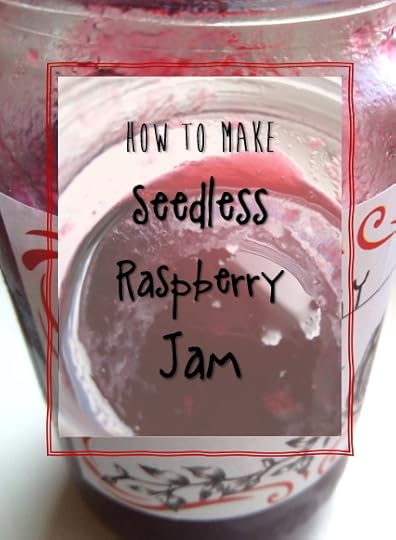
Ingredients
Raspberries
Sugar
Method
Whatever quantity of raspberries you have, weigh them. If you have less than about 200g, it’s probably not worth the effort to make jam, as by the time it’s cooked and reduced, you will have less than a small jar! Jam is a great thing to make if you have a lot of raspberries, one punnet is probably not worth the effort.
Weigh your raspberries. A mix of ripeness is ideal – some very dark and ripe, some only just going pink
Weigh out an equal amount of granulated sugar (as raspberries have natural pectin you don’t need preserving sugar). Reduce the amount of sugar slightly if you prefer a sharper jam
Put your raspberries in a large heavy-based saucepan over a medium hob and crush them with a spoon to start releasing the juices
Pour in sugar, stirring as you go
As the sugar dissolves, crush the fruit some more, the sugars will draw out the juices
If you want a seedless jam, once all the sugar has dissolved, remove it from the heat and allow to cool slightly
Press the seedy syrup through a sieve into a jug to strain out all the pips, and push as much pulp through as possible
Pour the liquid back into the saucepan and return to the heat. Optional, squeeze a little lemon juice in to speed up the setting process and add a little more tartness
Turn up the heat and boil the syrup rapidly for about 10 minutes (longer for larger quantities, less for smaller amounts). You need a deep pan as it will bubble right up to the top. You don’t need to stir it but you do need to keep an eye on it. Stirring will keep the bubbles down
This is where you need to be vigilant, as there is a fine line between reaching setting point and overcooking the jam. You are looking for a loose but not too sloppy end result
To test for set: Pull the pan off the heat and allow the bubbles to drop. Drag a wooden spoon through the residues on the sides of the pan, if it runs back down it’s not set, if it leaves a gully where the spoon was, you’re getting there. Take a small blob of jam out, drop it onto a cold plate and allow it to cool. If it doesn’t stay in a blob it’s not ready and needs to go back onto the heat and boil for a little longer. If it stays as a blob, let it cool then push your finger through the blob and if the surface crinkles, it’s ready. Keep boiling and testing until you reach the desired set point
Once the set point is reached, remove from the heat and allow the jam to cool a little. While the jam is still liquid, pour it into your sterilised jars, seal and label. Leave the jars to cool. Store in a cool dry place until ready to use. Refrigerate once opened
Strawberry Jam

Ingredients
Strawberries
Sugar
Lemon
Method
Whatever quantity of strawberries you have, weigh them. If you have less than about 200g, it’s probably not worth the effort to make jam, as by the time it’s cooked and reduced, you will have less than a small jar!
Wash, hull and roughly chop your strawberries
Weigh your strawberries. A mix of ripeness is ideal – some very dark and ripe, some still a little green
Weigh out two thirds the amount of granulated sugar (i.e. 2 cups of sugar to three cups of strawberries)
Put your strawberries in a large heavy-based saucepan bring them to the boil until juices start to run. Depending on how chunky you want your jam, crush them with a spoon or potato masher to start releasing the juices.
If you like fewer and softer chunks, continue boiling and crushing the fruit until it’s the desired consistency. I like mine chunky so skip this step.
Pour in sugar, stirring as you go.
As the sugar dissolves, crush the fruit some more, the sugars will draw out the juices.
Once the sugar has dissolved squeeze in the juice of half a lemon for approximately every 500g of strawberries
Turn up the heat and boil the syrup rapidly for about 10 minutes (longer for larger quantities, less for smaller amounts). You need a deep pan as it will bubble right up to the top. You don’t need to stir it but you do need to keep an eye on it. Stirring will keep the bubbles down
This is where you need to be vigilant, as there is a fine line between reaching setting point and overcooking the jam. You are looking for a loose but not too sloppy end result.
To test for set: Pull the pan off the heat and allow the bubbles to drop. Drag a wooden spoon through the residues on the sides of the pan, if it runs back down it’s not set, if it leaves a gully where the spoon was, you’re getting there. Take a small blob of jam out, drop it onto a cold plate and allow it to cool. If it doesn’t stay in a blob it’s not ready and needs to go back onto the heat and boil for a little longer. If it stays as a blob, push your finger through the blob and if the surface crinkles, it’s ready. Keep boiling and testing until you reach the desired set point
Once the set point is reached, remove from the heat and allow the jam to cool a little. While the jam is still liquid, pour it into your sterilised jars, seal and label. Leave the jars to cool. Store in a cool dry place until ready to use. Refrigerate once opened
The Devon or Cornish Way?
Now you have your cream, jam and scone, it’s time to assemble your perfect Cream Tea.
A hotly contested and controversial conversation: which is best, jam first or cream first?
This is a big deal if you are British and we have strong opinions about such earth-shattering matters!
The Devon Method:
Split the scone in two, daub on lashings of cream then top with jam.
The Cornish Method:
Split the scone in two, spread jam on first then top with cream.
Team Cream First
Personally, I like Cream First because I like a lot of cream and find it easier to add extra cream if that goes first. I also like a clear separation between the cream and the jam, I find if I do it the other way, the two tend to mix and it’s harder to add more cream because it just slides off the jam. Also, it looks nicer and more Instagramable with jam on top!
If you like lots of jam, go the Cornish method and spread the jam first, (you filthy animal), then top with a piffling amount of cream, (you weirdo)!

Although I absolutely love a good coffee, the only thing to drink with a Cream Tea is, of course, a good brew of tasty British Tea. This really is the taste of the summer!

 Flip This on Flipboard
Flip This on Flipboard
Follow me on Bloglovin’
If you like what you’ve read, say thank you by topping up the coffee kitty here. £2.50 /$3 will get me a cappuccino, Thanks

July 18, 2020
5 Content Marketing Trends For 2020
Content Marketing is always evolving.
A contributor suggests 5 trends for 2020.
2020 Trends
Doug Kessler once said, ‘traditional marketing talks at people. Content marketing talks with them.’ As the marketing world shifts to focus more on the consumer, there are plenty of trends that can help you to to drive leads. Next time you’re giving your content marketing a revamp, be sure to pay attention to these five ideas.
Natural Language
In 2020, using natural language is important for content marketing. Firstly, this is because natural language helps you to optimise for voice search. Secondly, content that’s chatty and informal often performs better than content that’s overly complex or full of jargon. When designing your marketing chatbots, go for conversational language here too.
More Video
The video trend just keeps on growing from video ads to live streaming, animations and 1:1 video marketing. In our current age of marketing consumers like videos that are fun and insightful. You should aim to create videos that inspire an emotional reaction (and inspires those shares)! To create innovative video content, the best thing to do is to work with a talented video production agency. With the help of a professional agency, your brand can get yourself some video content that truly stands out.
Podcasts
Podcasts have fast gained popularity over the last few years, and there are plenty of benefits to creating a podcast for your company. First of all, podcasts are a popular form of entertainment, if you create educational content your brand will become known for something besides your products. Podcasts allow your business the opportunity to establish credibility, increase engagement, and boost brand awareness.
According to Hubspot ‘ 54% of podcast consumers say that they are more likely to consider the brands they hear advertised on podcasts.’ What’s more, ‘Podcast advertising revenue is expected to pass $1 billion by 2021.’
Personalized Content
Personalized content is a great way to drive leads and appeal to the values of your consumers. Smarter HQ report that, ‘marketers are sending just 30% more individualized campaigns than batch and blast emails.’ As well as this, 92% of marketers reported using personalization techniques in their marketing.’
To create personalized content you need to collect meaningful and useful data. Such data might include preferences, demographics, priorities or how the consumer uses your product. When you talk to your audience on an individual level your campaigns will be more authentically perceived.
Interactive Content
Interactive content is all the rage this year, to improve your audience engagement it’s time to jump on the bandwagon. Interactive content can take many forms including polls, tests, calculators or quizzes. Consumers are much more likely to offer their insights when the content is fun and interactive.
It’s essential to analyse all of the data that you get from your content marketing campaigns. Using these insights you can develop your content so that it’s more in tune with the values and desires of your audience. There is plenty that you can learn from your marketing campaigns.
The post 5 Content Marketing Trends For 2020 appeared first on Amy Morse.
July 14, 2020
How To Make Sourdough Bread

We’ve been conditioned to know the cost of everything and the value of nothing.
Since the Industrial Revolution, time and money have been inextricably linked.
One thing many of us have learned during the Coronavirus Crisis is the value – the currency – if you like, of time.
Suddenly, we have the time to realise what is really important to us.
On top of the list of ‘Things To Do In Lockdown‘ clichés is probably baking sourdough!
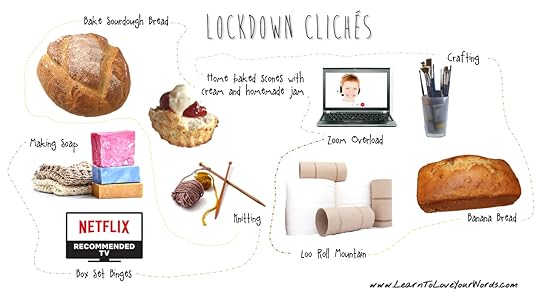
But, is really worth the effort?
When it comes to our daily bread, what’s the best value?
While it may be financially cheaper to get shop-bought mass-produced bread, it’s not necessarily a saving when you consider the cost to the environment (for example, with lengthy supply chains and plastic packaging), and the cost to your health.
My response to the question on a Frugal Living group on Facebook about the cost vs the value of home-baked bread was, it depends…
Sometimes, a cheap white sliced loaf is enough to satisfy your kids or give you something quick and cheap to eat, but it’s nutritionally dubious!
Other times, you may prefer an artfully made loaf, fashioned by thrillingly wrinkled fingers.
Perhaps bread with all sorts of tasty things added like olives, herbs, nuts, seeds or onions? You can pay upwards of £4 for such luxurious bread from a local bakery. A delicious, nutritious but potentially expensive habit!
So, why not try it at home instead?
You can’t put a price on the sense of satisfaction of baking your own bread. Or the wonderful smells filling your home. The joy of seeing it double in size and bubble up gorgeously when kissed with a little heat.
Once you master basic bread dough, the possibilities are endless.
The basic dough ingredients are inexpensive (flour, yeast, salt and water), as are the additives (herbs, spices, oils, milk, seeds, etc.), especially if you grow your own herbs.
You can make batches of a simple dough to keep in the fridge for several days and use it when required.
A bread machine is brilliant and simple for this. I’ve never regretted the purchase of my Morphy Richards bread machine. I even had to replace the pan because I wore it out making so much bread!
Once you have your basic dough, you can batch off what you need, kneading in other ingredients later.
Knead in your goodies, shape it, let it rise then bake it.
There are plenty of good books of bread machine recipes for inspiration and you can collect your favourite recipes from blogs and online articles on Pinterest.
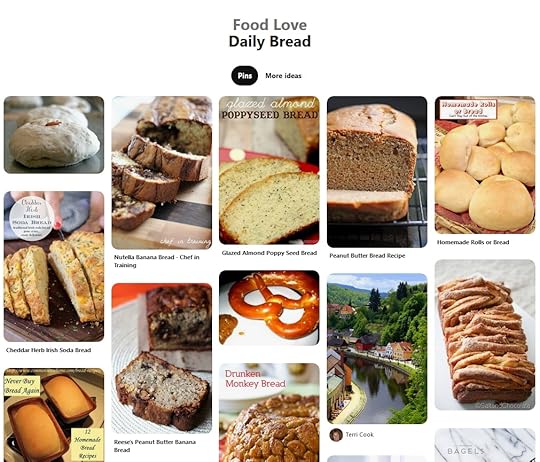
Follow my ‘Daily Bread’ Pinterest Board
Old Fashioned Bread
Making bread from scratch the old fashioned way is something I’ve not done for a while – thanks to my mate Morphy Richards.
One thing I often buy from the bakery is a springy sourdough with a gorgeous crispy bubbly crust. The gnarlier and crunchier the better.
Now seemed like the perfect time to have a go at making my own.
Bring Home The Bread
Bread is a fantastic metaphor for small business.
Yes, you could be the cheap white, mass-produced loaf – or you could choose to be the lovingly prepared oat-dusted crunchy sourdough.
I want to live in a world where more businesses are sourdough and fewer businesses are massive environmentally destructive flimsy white bread.
Cheap does not always mean cheerful.

What Is Sourdough?
Sourdough is a naturally cultured fermented bread.
During the baking process, rather than using commercial yeast, either dried or fresh, you effectively ferment your own yeast culture with a Soughdough Starter.
How To Make A Sourdough Starter
To answer this question I bought a book.
That tends to be my default; wanna learn something, get a book!
My learning style is seeing things, reading / writing about them to embed my learning, then having a go.
I bought this book…
There are some issues with the layout of this book, but the content is fine and I used this starter method for my first attempt at a sourdough culture.
For my first loaf, I wanted to make something simple and found a recipe in this old leaflet.

Don’t judge me, I don’t read The Daily Mail, but I was given this booklet ages ago and it has a selection of different bread recipes, including two sourdough recipes.
I used good quality flour from the farm shop for my starter, rather than the cheap supermarket stuff. But I’m happy to use the cheap stuff to make a loaf.
I felt for a good quality starter that I could keep fed and healthy indefinitely I should use better quality flour.
The basic Steps to Create a Sourdough starter
You will need:
Good quality unbleached strong white bread flour
Warm water
A large jar – A Kilner Jar would be ideal (I’ve also used an old large mayo jar with a plastic layer inside the lid)
Wooden spoon
Method one
The big bowl on a sunny windowsill method
This is the one in the book and was my first attempt.
Essentially, the basis of this starter is to use equal amounts of warm water and flour and keep feeding and discarding it.
Add a cup of unbleached white organic bread flour and a cup of warm water to a non-metallic mixing bowl, stir with a wooden spoon. Cover with a tea towel and place on a warm windowsill.
I rinsed the tea towel thoroughly with cold water first to get rid of any traces of fabric softer in case it tainted the brew.
Apparently, mental can react with the acids in the fermentation process so best to avoid metal spoons bowls or jar lids (unless they are coated inside).
After 24 hours, pour out half the mix then add another half cup of flour and half cup of warm water, stir, cover and leave on the windowsill.
Repeat this process for 7 days.
Method two
The jar in the fridge method
This is the one in the leaflet and was my second attempt.
Day 1 mix 1 Tbsp of unbleached white organic bread flour and 2Tbsp of warm water in a jar. Seal the jar and stand overnight somewhere warm.
Days 2, 3, 4, 5 Each day add 1Tbsp flour and 2Tbsp warm water to the jar and stir. Over time, more and more bubbles will form on the surface.
Day 6 – Make the starter. In a large bowl, mix 1 tbsp from the jar with 150g (5 1/2 oz) flour and 150ml warm water. Cover and let ferment overnight. The next day, use the quantity required for your recipe and discard the rest.
Store the starter jar in the fridge and feed it each time you use some.
My first batch didn’t work.
I tried to make a dough with my starter from method 1 and despite leaving it overnight it didn’t rise. I think it was user error rather than the fault of the recipe from the book – I ‘killed’ it when I accidentally stirred my mix with a metal spoon!
However, since then, I read that the acid liquid film on top of the starter was an indication that it had gone dormant. I drained off the liquid, fed a small batch of the starter again and continued to top it up with flour and warm water every day for a further few days to see if I could revive it.
I didn’t waste my unrisen dough, however. It was still a lovely springy and elastic dough so I used it to make flatbread (from step 7 in the recipe below).
Simple, Unleavened Flatbread
This simple flatbread is perfect with curries, soups, falafel, pasta, chilli…
Spread it with garlic butter while you’re cooking the reverse side for a perfect accompaniment to pasta.
In Bulgaria (we lived there for a while) it’s called Parlenka bread and is traditionally served with feta style cheese crumbled over it.
When you’re making a quick lunch and realise you have no fresh bread in the house a simple flatbread is hearty, tasty and quick lunch with whatever fillings you have to hand.
Great for ripping and dipping into a boiled or poached egg for breakfast. Or spread it with mashed avocado and top with a poached egg for a satisfying weekend brunch.
Ingredients
Flour (strong bread flour, self-raising, gram or plain flour all work) – about a cup per portion
Warm water
Salt (a generous pinch)
Method
Pour a small pile of flour onto a clean work surface.
Sprinkle over a little salt.
Make a well in the middle.
(Optional: drizzle in a little oil – this helps give the bread more richness and make it more malleable)
Slowly and methodically drizzle water into the well, using a fork to sweep in the flour, mixing continuously until it starts to come together in a dough.
When the dough mix loses its stickiness and starts to come away cleanly from the surface, spread out a dusting of flour on the work area.
Pull and knead your dough with floured hands, activating the gluten to create an elastic texture.
Roll, knead and pull the dough into a thin, flat sheet.
Heat a dry frying pan on the stove.
Drop-in your flat dough and stretch across the pan
Cook on a high heat for a couple of minutes until it starts to brown and even blisters and blackens a little.
Flip it, then cook the reverse side.
If you have worked the dough well it will bubble and blister, which is very pleasing to watch. Eat warm, with your choice of topping.
The Successful Sourdough Batch
I’ve cultured a successful starter using method 2.
It takes a little forward planning to make a loaf, even with a premade starter.
The day before I plan to make my loaf, I take my jar of starter out of the fridge. Pour off any clear liquid carefully then pour about 100ml into another Kilner Jar or mayo jar with a plastic-coated inside lid.
‘Feed’ the starter with a generous tablespoon of strong white bread flour and 2 tablespoons of lukewarm water. Stir in the water and flour using a wooden spoon, NOT a metal spoon. Give it a little shake and leave it overnight on the warmest windowsill in the house.
The next day, I start my dough early and can usually get a loaf ready for lunch. If you do it later in the day and leave the shaped and prepared loaf overnight in the fridge, take it out and allow it to get up to room temp for 30 – 60mins and rise a little more then it’s good to go for a breakfast loaf.
Ingredients
250g (9oz) Strong White Bread Flour
150ml (5 fl oz) warm water
Level tsp salt
75ml (2 3/4 oz) Sourdough Starter
Tbsp Olive Oil (optional)
Method
You need 2 non-metallic mixing bowls. In one bowl, combine the wet mix (water, starter and oil) – If you use the dough for a pizza base add oil as it helps keep the dough malleable if you are making a loaf leave out the oil. In the other bowl combine the salt and flour.
Add the dry mix to the wet mix and stir with a wooden spoon (NOT metal) until it combines to a sticky dough.
Put the bowl from the dry mix over the bowl and let it rest for 10 minutes.
Kneading stage: Flour your hands. Scoop the dough away from the bowl if it has stuck. Leaving the dough in the bowl, stretch a portion of it up the side and press into the middle, turn the bowl and repeat the process until the dough resists. Cover with the bowl and leave for 10 minutes
Repeat the kneading stage three more times, leaving it to rest for 10 minutes between kneads. Leave the covered bowl for 1 hour to rest.
Lightly dust a worktop with flour and turn your dough out onto it, shape into a disk, then line a colander with a flour-dusted tea towel and place your dough in it to rise for 3 to 6 hours.
Preheat the oven at gas 7 / 200 degrees C. Pour a cup of water into a baking tray and place this in the bottom of the oven.
Place your dough on a lined/non-stick baking sheet and bake for 30 minutes or until golden brown. To check if it’s ready, tap the bottom of the loaf, it should sound hollow. If it’s still a bit soft cook it for a few more minutes.
Result!
It’s not the most Instagramable but here’s my first springy and tasty loaf!

I’ve had mixed results with whole loaves, but the dough makes a couple of good-sized bread rolls, 4 smaller rolls or an awesome pizza base!
I feed the starter mix each time I’m planning to make a loaf and the old starter in the fridge has taken on much more ‘sourness’ over time. The first batches from that starter made lighter loaves, the later ones, as I’ve found my stride with the process have been more flavourful.
Enjoy your fresh and tasty bread! Definitely beats stuff that comes wrapped in plastic!
 Flip This on Flipboard
Flip This on Flipboard
Follow me on Bloglovin’
If you like what you’ve read, say thank you by topping up the coffee kitty here. £2.50 /$3 will get me a cappuccino, Thanks

July 9, 2020
Why Hackers Are Targeting Start-Ups and How to Protect Your Young Venture – A Guest Post
Featuring a guest post this week on cyber security and the measure you can take as a small business to protect yourself…
Why Hackers Are Targeting Start-Ups and How to Protect Your Young Venture

image from unsplash.com
In August 2013, Yahoo! was hit by a cyberattack where over 3 billion user accounts were hacked. The fallout from the biggest cyberattack to date is estimated to have reduced the company’s value by $350 million when it was finally bought by Verizon in 2017. Since then, incidents of cyberattacks and data breaches seem to be dominating the news cycle.
In most cases, high-profile breaches such as Yahoo! will dominate the headlines but its start-up companies and small businesses that are most vulnerable. Smaller businesses seem to be a favorite target of high-tech villains. Large businesses are increasingly dedicating more resources to and becoming savvier about cybersecurity and as a result, cybercriminals are turning their attention to smaller businesses.
Common Cyber security Threats
The vast majority of start-up entrepreneurs and small business owners believe that their businesses don’t have anything of value to steal and, therefore, can’t be the target of cyberattacks. Well, this is simply not true. Start-ups have a lot to protect including customer information, reputation, brand, and intellectual property. Here are a few cyberthreats start-ups should be concerned about.
● Phishing. According to a 2019 Internet Security Threat Report by Symantec, employees in smaller companies have a higher likelihood of being targeted with phishing attacks email malware compared to their counterparts in larger organizations.
● Malware. Small businesses are commonly targeted by malware attacks. Malware attacks can cripple your start-up’s systems or render them useless. Forbes predicted a 300% increase in ransomware attacks in 2020, mostly targeting small businesses.
● Data Breaches. Any incident that exposes confidential or protected information can be described as a data breach. Data breaches may involve the loss or theft of passwords, email, or credit card information.
On average, a business will incur $200,000 in losses after a cyberattack. These costs arise from issues such as downtime, sustained system outage, cost of any data that may be lost, ransoms, and potential lawsuits. Data from the US National Cyber Security Alliance shows that 60% of small businesses that suffer a cyberattack go out of business within half a year. Here are a few cybersecurity tips to help you avoid these consequences.
● Risk assessment. A vulnerability assessment will help you identify, quantify, and prioritize the risks and vulnerabilities in your system. You will be able to isolate recognized threats and threat actors as well as the likelihood that these risks will lead to loss or exposure.
● Cyber security training. Training your employees on cyber security best practices is essential. There is a growing number of cyberattacks that are directed at the employees’ lack of awareness today. Having employees who are unaware of the various threats out there makes your start-up more vulnerable.
● Outsource IT services. Many start-up entrepreneurs don’t have the resources to optimize their business for cyber security. Outsourcing your cybersecurity functions to a company that specializes in IT security gives you a convenient and reliable way to protect your start-up’s data.
● Create a backup. A good backup strategy is essential for cyber security. Backup provides your start-up with a way to restore lost or destroyed data. In the event of an attack, you can quickly restore your data and get back to business.
● Use a VPN. A VPN is one of the most effective ways to guarantee online privacy and anonymity. Secure VPN connections can help prevent DDoS attacks and provide an added layer of protection against various online threats.
Cyber security continues to occupy an expanding slice of conversations in the business world. With almost half of cyberattacks targeting start-ups and small businesses, these enterprises are most vulnerable to cyberattacks. But despite these statistics, a lot of start-up entrepreneurs believe that their businesses are too small to be targeted. This failure to recognize potential losses is perhaps the biggest cybersecurity risk facing start-ups.
The post Why Hackers Are Targeting Start-Ups and How to Protect Your Young Venture – A Guest Post appeared first on Amy Morse.
June 30, 2020
Self-Sabotage – How Do You Stop It?

I put my coffee cup down on this coaster on my desk this morning and realised that I do this… a lot… at the moment.
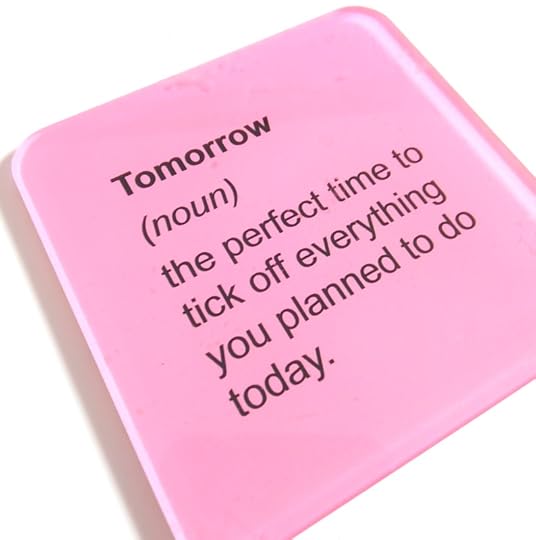
Self-Sabotage – The Promise of Tomorrow
Lockdown may be easing, but the weather is wet and miserable outside.
The prospect of queuing to buy stuff for the sake of stuff fills me with dread.
There are no cosy coffee shops open I can retreat to with my laptop.
Staying safe means life becomes the four walls of home in what can feel like an endlessly unfolding perpetual Groundhog Day.
Not that I have a problem with my home. It’s lovely, cosy, comfortable with plenty of rooms and a full fridge. There are plenty of people struggling to cope through this, and I’m grateful for the blessings I have – but that doesn’t stop me feeling restless and demotivated.
It’s so much easier to fill tomorrow with the things you could do today. Call it procrastination. Self-sabotage. Call it demotivation. Restlessness. Whatever name you give it, the simple act of giving it a name makes it ‘a thing’.
When you identify something as a thing, you can tackle it.
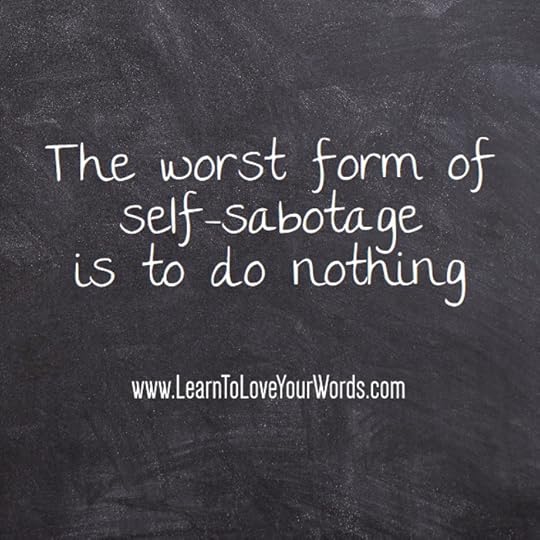
Write For Self Development
When I’m feeling challenged, my first therapy is to write. The simple act of writing about something is a productive activity. Sometimes, all it takes is to release the throughs, feelings, ideas, anxieties… into words and that can be enough to relieve then tension and clear the mental fog.
Other times, writing, even unintentionally is the first step to acknowledging that you need to take action.
Read For Self Development
My second therapy is to read.
I may be a visual learner – I like to see things, even when I read I visualise. But my next preference is to read a write about it. I’ll see something I want to learn more about, I’ll then read about it, write about it then take action.
When I want to learn a new skill, more than likely I will buy a book about it! But, like most people, my first instinct is to Google the topic and read blogs about it.
This time, I had a timely email on the topic of self-sabotage, with a link to this article: https://inlpcenter.org/aha-process-self-sabotage/
What is self-sabotage?
It’s when you get in your own way. And it’s hard to pin down.
The article features a video and a few other links and resources on the topic.
For a little ‘productive procrastination’, call it self development if you like, go and take a look.
 Flip This on Flipboard
Flip This on Flipboard
Does your micro-enterprise need support?
Book a FREE 30-minute Inspiration Call with me. Let’s see what we can do together!
For instant updates when I publish a new blog post, Follow me on Bloglovin’
For extra goodies and exclusive new information, join my mailing list HERE.
The post Self-Sabotage – How Do You Stop It? appeared first on Amy Morse.
June 24, 2020
Playful Blogging – Authentic Creativity On Your Blog

“There’s no evidence to suggest that life is serious.”
I don’t know who, if anyone, famously inspirational ever said that but I say that!
Life is for being playful.
Life is for living, loving and having fun.
That’s not to diminish or devalue the overwhelming challenges we face in the world, just not to immerse ourselves in fear and worry.
That’s no way to live!
So many entrepreneurs approach their business with a seriousness that belies their personality. You need a jackhammer to break through all the impenetrable layers of jargon they use in their blogs and other content. Because that’s how you ‘should’ do business; wearing a suit, being stoic and serious. Using big words to impress others with your massive brain and ample vocabulary!
You can be far more authentic than that with a little creativity.
Boo to that!
If anything, the overuse or the latest trendy piece of business jargon doesn’t reach any blue skies, push any envelopes or disrupt anything. All it does it showcase your limited vocabulary and inability to explain things to humans!

OK, so there are exceptions, depending on what your business is, but that doesn’t mean your blogs must always be serious and formal too!
The Job Of Your Blog Is Not To Sell
This is one of the most common mistakes I see people make with their blogs.
It’s also something that puts many people off starting a blog for their business in the first place; they believe they need to ‘sell themselves’ in their blogs.
Many micro-business owners start a blog then give up when it doesn’t convert in the way they expect it to.
The Real Job of Your Blog is to Cultivate Your Brand
It’s about showing people what it feels like to work with you and your business.
Your blog is not the till.
Your blog is the shop fittings, the vibe and feel of the virtual store. Displays in the windows. Helpful and smiling staff who love the things you do. The whole personality of the business – not just the stuff you sell.

Playful and Purposeful
I always approach my blog writing with a sense of creative purpose.
I like to have fun with it. Be playful. To express my personality. I want to give people a sense of who I am, what I stand for and what’s important to me.
Because I am my business, what’s important to me, is reflected in how I operate as a business.
When I say, “what it feels like to work with me,” I don’t just mean paying clients. In reality, actual paying clients will only be small part of the audience reading your blogs – because remember, the blog is not a sales device!
I mean the wider audience of people who engage with you, may never pay you a penny, but nevertheless are a crucial part of your network.
I call my business Learn To Love Your Words because the most important part of creating great non-fiction writing, that entertains and informs, is loving the process.
It’s about conveying the love you have for the thing you do through the way you show it to the world.
I hereby give you permission to have a little more fun with it!
Share amusing anecdotes
Play with metaphor
Be a little facetious or contrary
Get creative
Experiment with it
Avoid those tired business buzzwords and write about things that are important to you
Let your core values shine through, even when it’s not directly related to the day job
New Boundaries and Fresh Thinking
I’m lowering the boundaries a little around the topics I cover and the stories I tell on my blog.
You will notice a lot more random acts of creativity and seemingly unrelated blogs in the future. Because, ‘adventures and entrepreneurship’ (my theme for my blogs) are by definition, not only the one thing I am doing right now, but the many and varied entrepreneurial pursuits I will follow now and into the future.
Get Creative, get Playful and let’s shake things up a bit!
 Flip This on Flipboard
Flip This on Flipboard
Does your micro-enterprise need support?
Book a FREE 30-minute Inspiration Call with me. Let’s see what we can do together!
For instant updates when I publish a new blog post, Follow me on Bloglovin’
For extra goodies and exclusive new information, join my mailing list HERE.
The post Playful Blogging – Authentic Creativity On Your Blog appeared first on Amy Morse.
June 16, 2020
Why You Should Go It Alone In Your Business
Setting up your own business has never been more accessible. It’s why self-employment is one of the fastest-growing sectors of the economy. But being in business doesn’t mean having to employ a team of people and paying for expensive premises. Many businesses are literally starting, every day, from people’s kitchen tables.
Being self-employed doesn’t mean you have to do everything yourself, you can go it alone but also get the help you need without employing staff.
I’m sharing these insights from a contributor to demonstrate that having big dreams can start small.
It starts with you.
Big Dreams Start Small
Everyone will tell you that you have to start a business with the help of others. They will say that you need xyz amount of people to help you to run things, and you need to have people on speed dial to ask their advice. You don’t. Realistically, it would be nice to have a whole team of people working with you but it’s not always possible – which means that you need to work out how to go it alone.
You have an idea to put into practice, and while you can use services like physicaladdress to help you with your business you can make it work. You can go it alone without others if you want to, and we’ve got a few reasons why you should do it.

Image source: Pexels
There’s No Shared Responsibility.
The blame game is a big thing in business. You could have a team of people with you and a whole board of directors equal to you. However, when things go wrong, it’s a blame game of passing the buck from person to person. Without a team around you, you would have everything on your shoulders and you are coping with it alone. This means that the buck stops with you.
It’s Your Baby.
When a team is working together, the commitment by each person in the team is uneven. Some people will do more than others, and they’ll take equal glory to those who do less. So, when you work alone, you’re working on your business and you are committed – and gaining all the glory for it, too!
Quick Decision-Making.
When you don’t have to rely on other people to make decisions, you can make the right decisions for yourself. Decisions are not delayed and you don’t have to worry about tensions in the team if someone doesn’t agree with the way that you do things.
No Distractions.
This is your idea and your business. When you go it alone, you’re doing it all without the distractions of other people and their input. You can plan whatever you want for your business and make it so that your business goes in the direction in which you have always dreamed.
No Office Politics.
You can pay for the help of outsourced resources and virtual addresses without dealing with the office politics that comes with having a team on hand. You can pay for the services you need help with, without dealing with differing opinions and a range of personalities potentially clashing. You need to have a solid business and that starts with just you.
To go it alone isn’t a bad thing. You need to be able to see where your business is going and steer it in the right direction. When you do that, you make a conscious decision to have a business that will be successful in your own eyes. Take the time to plan things properly and one day, when you’re established, you can start to gradually bring others on board!
The post Why You Should Go It Alone In Your Business appeared first on Amy Morse.







